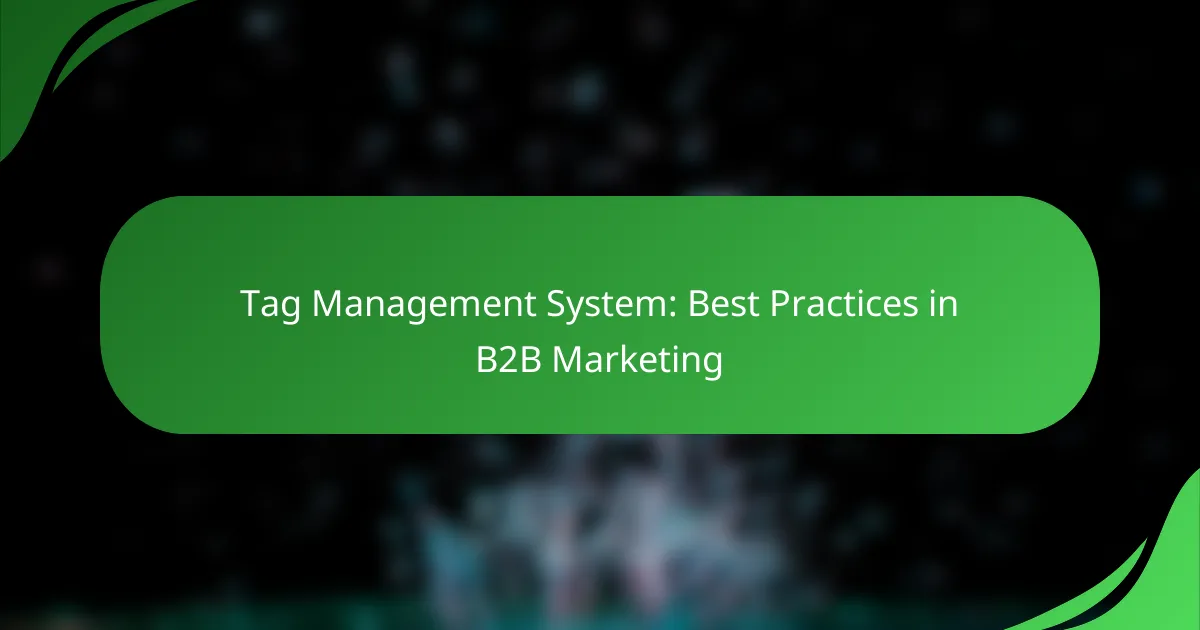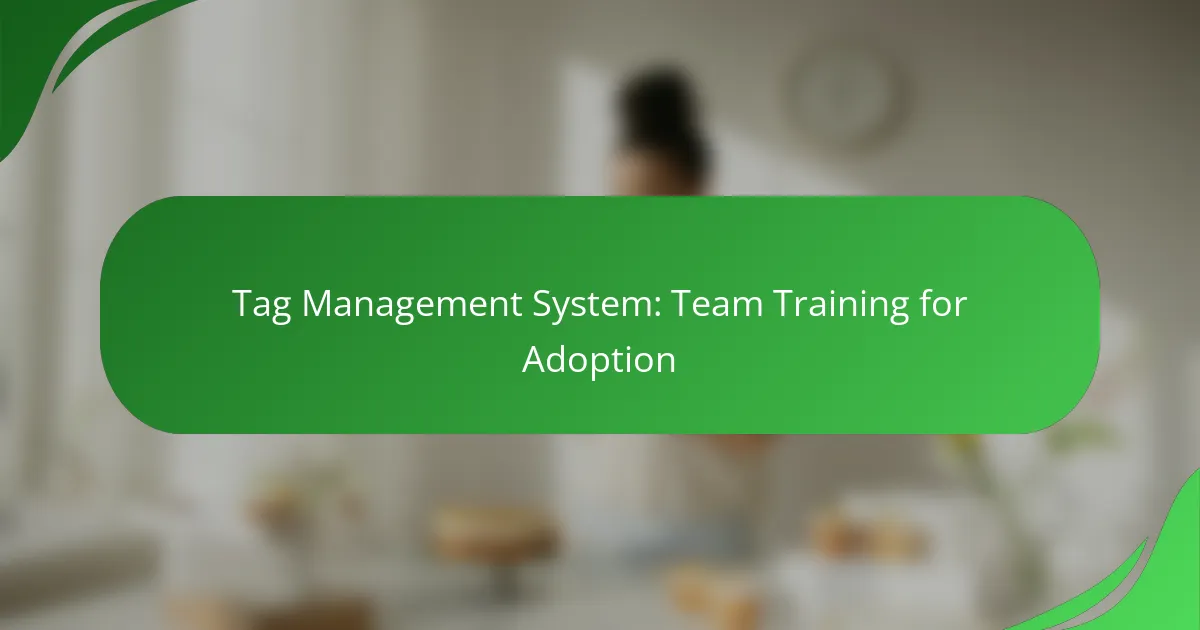In B2B marketing, implementing best practices for a tag management system (TMS) is crucial for achieving efficiency, accuracy, and compliance. A well-structured TMS streamlines the deployment of tracking codes, enhances data collection, and improves marketing analytics, leading to more informed decision-making and effective strategies.

What are the best practices for tag management systems in B2B marketing?
Best practices for tag management systems (TMS) in B2B marketing focus on efficiency, accuracy, and compliance. Implementing a robust TMS can streamline data collection and improve marketing analytics, ultimately enhancing decision-making processes.
Implementing a centralized tag management system
A centralized tag management system allows businesses to manage all tracking codes from a single platform. This reduces the complexity of handling multiple tags across various marketing channels and ensures consistency in data collection.
When choosing a TMS, consider factors like user-friendliness, integration capabilities with existing tools, and support for various tag types. Popular options include Google Tag Manager and Adobe Launch, which offer extensive features for B2B marketers.
Regularly auditing tags for accuracy
Regular audits of your tags are crucial for maintaining data integrity. This involves checking that all tags are firing correctly and that they align with your marketing goals.
Set a schedule for audits, such as quarterly or biannually, and utilize tools that can help identify issues like duplicate tags or broken links. This proactive approach minimizes data discrepancies and ensures reliable analytics.
Utilizing data layer for enhanced tracking
Implementing a data layer can significantly enhance tracking capabilities by providing a structured way to collect and manage data. A data layer acts as a bridge between your website and the TMS, ensuring that relevant data is captured accurately.
Define key variables in the data layer, such as user interactions and product details, to facilitate better tracking of customer journeys. This structured data can improve insights and help tailor marketing strategies effectively.
Ensuring compliance with privacy regulations
Compliance with privacy regulations, such as GDPR in Europe or CCPA in California, is essential when managing tags. Ensure that your TMS is configured to respect user consent and data preferences.
Regularly review your tagging practices to ensure they align with current regulations. This includes providing clear opt-in options for users and maintaining transparency about data usage to build trust with your audience.

How can tag management improve B2B marketing performance?
Tag management can significantly enhance B2B marketing performance by streamlining the deployment and management of tracking codes. This efficiency leads to better data collection, faster website performance, and improved user interactions, ultimately driving more effective marketing strategies.
Faster website loading times
Implementing a tag management system (TMS) can lead to faster website loading times by minimizing the number of tags that load on each page. By consolidating tags and controlling when they fire, businesses can reduce the overall load on their servers, resulting in quicker page responses.
For example, a well-optimized TMS can decrease page load times from several seconds to low tens of milliseconds. This improvement not only enhances user satisfaction but also positively impacts search engine rankings, which is crucial for B2B visibility.
Improved data accuracy and insights
A tag management system enhances data accuracy by ensuring that tracking codes are implemented correctly and consistently across all digital platforms. This leads to more reliable data collection, allowing businesses to gain valuable insights into user behavior and campaign performance.
With accurate data, B2B marketers can make informed decisions based on real-time analytics. For instance, using a TMS can help identify which marketing channels yield the highest conversion rates, enabling more effective allocation of resources and budget.
Enhanced user experience
By optimizing tag management, businesses can create a smoother user experience. A TMS allows for the quick adjustment of tags without needing extensive coding, which means marketers can respond rapidly to user feedback or behavioral changes.
For example, if a particular feature on a website is causing delays, a TMS enables marketers to quickly modify or remove the associated tags. This agility helps maintain a seamless interaction for users, which is essential in B2B environments where user engagement can directly influence sales outcomes.

What are the key features of a tag management system?
A tag management system (TMS) simplifies the management of marketing and analytics tags on a website. Key features include a user-friendly interface, version control, and integration capabilities with analytics platforms, all of which enhance efficiency and accuracy in tracking user interactions.
User-friendly interface
A user-friendly interface is crucial for a tag management system, as it allows marketers to easily add, edit, and manage tags without extensive technical knowledge. Look for systems that offer drag-and-drop functionality and intuitive dashboards to streamline the process.
For example, a TMS with a clear layout can help users quickly locate tags, view their status, and make necessary adjustments. This reduces the time spent on tag management and minimizes errors.
Version control and rollback options
Version control and rollback options are essential features that allow users to track changes made to tags over time. This functionality enables marketers to revert to previous versions if a new tag implementation causes issues, ensuring website performance remains stable.
Consider a TMS that automatically saves versions each time a tag is modified. This way, users can easily restore a prior version with just a few clicks, avoiding potential disruptions in data collection.
Integration with analytics platforms
Integration with analytics platforms is a vital feature of a tag management system, as it ensures seamless data flow between the TMS and tools like Google Analytics or Adobe Analytics. This connectivity allows for more accurate tracking and reporting of user behavior.
When selecting a TMS, check for compatibility with your existing analytics tools. A well-integrated system can enhance data insights and improve marketing strategies by providing comprehensive user interaction data.

Which tag management systems are popular in Canada?
In Canada, several tag management systems (TMS) are widely used to streamline marketing efforts and enhance data collection. Popular options include Google Tag Manager, Adobe Launch, and Tealium iQ, each offering unique features and capabilities suited for B2B marketing.
Google Tag Manager
Google Tag Manager (GTM) is a free tool that allows marketers to manage and deploy marketing tags without extensive coding knowledge. It simplifies the process of adding and updating tags, enabling quick adjustments to tracking and analytics setups.
GTM supports a variety of tags, including those for Google Analytics, AdWords, and third-party tools. Its user-friendly interface and robust community support make it a popular choice for Canadian businesses looking to optimize their marketing strategies.
Adobe Launch
Adobe Launch is part of the Adobe Experience Cloud and offers advanced features for managing tags across multiple platforms. This TMS provides a flexible framework that allows for seamless integration with Adobe’s suite of marketing tools, making it ideal for businesses already invested in Adobe products.
With Adobe Launch, users can create rules and conditions for tag firing, which helps in customizing data collection based on specific user interactions. While it may have a steeper learning curve compared to GTM, its powerful capabilities are beneficial for larger organizations with complex marketing needs.
Tealium iQ
Tealium iQ is a comprehensive tag management solution that focuses on data governance and privacy compliance, which is increasingly important in Canada. It allows businesses to manage their tags while ensuring adherence to regulations like PIPEDA.
This TMS offers a wide range of integrations and features, including audience segmentation and real-time data collection. Tealium iQ is particularly suited for enterprises that require detailed analytics and personalized marketing strategies, making it a strong contender in the Canadian market.

What criteria should be considered when selecting a tag management system?
When selecting a tag management system (TMS), consider factors such as ease of use, scalability, integration capabilities, and support for compliance with data regulations. These criteria ensure that the TMS can effectively manage tags as your business grows and adapts to new marketing tools.
Scalability for future growth
Scalability is crucial when choosing a tag management system, as it needs to accommodate increasing data volume and complexity over time. A TMS should allow for the addition of new tags without significant performance degradation, enabling your marketing efforts to expand seamlessly.
Look for systems that can handle a growing number of users and tags, ideally supporting hundreds or thousands of tags without impacting load times. A good TMS will also provide features like version control and automated updates to keep pace with your evolving needs.
Support for multiple marketing tools
Effective tag management requires compatibility with various marketing tools, such as analytics platforms, advertising networks, and CRM systems. A TMS should offer built-in integrations or easy customization options to connect with these tools, streamlining your marketing operations.
Evaluate the TMS’s ability to integrate with popular platforms like Google Analytics, Facebook Ads, and email marketing services. This ensures that you can track and optimize campaigns across different channels efficiently, maximizing your marketing ROI.

How can businesses ensure compliance with data privacy regulations?
Businesses can ensure compliance with data privacy regulations by implementing robust data management practices that prioritize user consent and transparency. This involves actively managing user data in accordance with legal requirements and keeping customers informed about how their information is used.
Implementing consent management features
Consent management features allow businesses to collect, store, and manage user consent effectively. This includes providing clear options for users to opt-in or opt-out of data collection, ensuring that consent is freely given and specific.
Consider using consent banners that inform users about data collection practices and allow them to customize their preferences. Regularly review and update these features to align with evolving regulations, such as the GDPR or CCPA, which emphasize the importance of user control over personal data.
Regularly updating privacy policies
Regular updates to privacy policies are essential for maintaining compliance with data privacy regulations. Businesses should ensure that their policies reflect current practices, legal requirements, and any changes in data handling procedures.
It’s advisable to review privacy policies at least annually or whenever significant changes occur in data processing activities. Make these policies easily accessible to users and consider using plain language to enhance understanding. This transparency helps build trust and ensures users are aware of their rights regarding their personal information.

What are common challenges in tag management for B2B marketing?
Common challenges in tag management for B2B marketing include complexity in managing multiple tags, ensuring data accuracy, and maintaining compliance with privacy regulations. These issues can lead to inefficient tracking, data silos, and potential legal risks if not addressed properly.
Complexity of Multiple Tags
Managing numerous tags from various platforms can create significant complexity. Each tag may require different configurations and updates, leading to potential errors and inconsistencies in data collection. A streamlined approach, such as using a centralized tag management system, can simplify this process.
Consider categorizing tags by function or platform to better manage them. For instance, group marketing analytics tags separately from conversion tracking tags. This organization can help reduce confusion and improve efficiency in tag deployment.
Data Accuracy and Quality
Ensuring data accuracy is crucial for effective B2B marketing. Inaccurate tags can lead to misleading analytics, which can affect decision-making. Regular audits and validation of tag implementations can help maintain data integrity.
Implementing automated testing tools can also enhance data quality. These tools can quickly identify broken tags or discrepancies, allowing for timely corrections. Aim for a low error rate, ideally under 5%, to ensure reliable data collection.
Compliance with Privacy Regulations
Compliance with privacy regulations, such as GDPR or CCPA, poses a significant challenge in tag management. Tags that collect personal data must adhere to strict guidelines to avoid legal repercussions. It’s essential to understand the regulations applicable to your region and industry.
Consider implementing consent management solutions that integrate with your tag management system. This ensures that tags only fire when users have given explicit consent, helping you stay compliant while still gathering valuable data.



